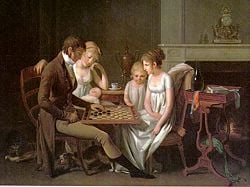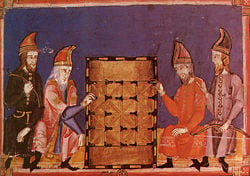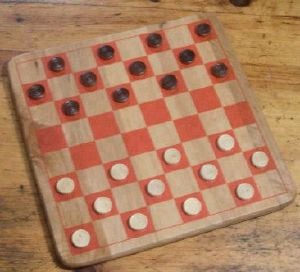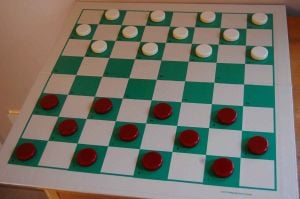Checkers
Rosie Tanabe (talk | contribs) |
|||
| (31 intermediate revisions by 4 users not shown) | |||
| Line 1: | Line 1: | ||
| − | [[Image:Boilly-Checkers-1803.jpg|thumb| | + | {{Images OK}}{{submitted}}{{approved}}{{copyedited}} |
| − | ''' | + | {{epname|Checkers}} |
| + | [[Image:Boilly-Checkers-1803.jpg|thumb|250px|Painting of a family game of checkers (1803)]] | ||
| + | '''Checkers,''' also called '''English draughts,''' '''American checkers,''' or '''straight checkers,''' is a form of the [[draughts]] [[board game]] played on an eight-by-eight board with 12 pieces on each side that may only move and capture diagonally. | ||
| − | The origin of | + | The origin of the game can be traced as far back as the [[Iraq]]i city of [[Ur]] dating to about 3,000 B.C.E. Pharaonic Egyptians also played a checkers-like game called [[Alquerque]] on a five-by-five board. The Greek [[philosopher]]s [[Homer]] and [[Plato]] mention a draughts-like game in their works. In about 1100, the French used a 64-square chessboard to play the game. Later, the rules became more set and its popularity spread to [[Great Britain]], where it was called "draughts." In America it became known as "checkers." When a rule requiring the capture of opposing pieces was added to the game, rather than making this optional, it became the same as modern checkers. |
| + | {{toc}} | ||
| + | The first world championship for the game was awarded in 1847. Random opening moves were later added to reduce the frequency of draws. [[Computer]] programs, first developed in the 1950s, have proven stronger checkers players than their human counterparts. It has now been proven mathematically that if neither player makes a mistake, the game will always end in a draw. | ||
==History== | ==History== | ||
| − | [[Image:Alquerque in Libro de los juegos.jpg|thumb|250px| | + | [[Image:Alquerque in Libro de los juegos.jpg|thumb|250px|The ancient Egyptian game of Alquerque]] |
| − | |||
| − | |||
| − | At the time of the earliest Egyptian [[pharaohs]], a popular, checkers-like game called [[Alquerque]] was played on a five-by-five board. The | + | English draughts has it origin in ancient times. [[Carbon dating]] of a game similar to draughts/checkers discovered in an archaeological dig in the [[Iraq]]i city of [[Ur]] dates to about 3,000 B.C.E. Although the precise rules of the game are not known, the board and number of pieces is not much different than today’s game. |
| + | [[Image:USSMonitor1862.1.ws.jpg|thumb|250px|Checkers players on the [[USS Monitor|USS ''Monitor'']] c. 1862.]] | ||
| + | At the time of the earliest Egyptian [[pharaohs]], a popular, checkers-like game called [[Alquerque]] was played on a five-by-five board. The [[greece|ancient Greeks]] had a similar game as far back as 1600 B.C.E., with classical Greek philosophers [[Homer]] and [[Plato]] mentioning it in their works. So great was the attraction of the game that it was played throughout the [[Western World]] for thousands of years. | ||
| − | The rules changed in about 1100 when the French utilized a 64-square chessboard to play the game | + | In France, the game was known as [[Fierges]]. The rules changed in about 1100 when the French utilized a 64-square chessboard to play the game. The newer French version was called [[Jeu Force]] (Strong Game), while the older version considered a gentile, social game for women and therefore known as [[Le Jeu Plaisant De Dames]] (Pleasant Game for Ladies). |
| − | Later, the rules for checkers became fixed and the game found a ready pool of players in Great Britain and [[America]]. In England, the game was called "draughts." | + | Later, the rules for checkers became fixed and the game found a ready pool of players in [[Great Britain]] and [[America]]. In [[England]], the game was called "draughts." The game became fundamentally the same as modern checkers when the rule requiring the capture of opposing pieces was added. In mid-sixteenth century [[Spain]], books were written on the game. In 1756, [[William Payne]], an English mathematician, wrote a learned [[treatise]] on draughts. |
| − | The game has never relinquished its popularity, with the first world championship | + | The game has never relinquished its popularity, with the first world championship occurring in 1847. However, it was eventually realized that with specific openings, the side to move first always had the advantage. Therefore, in 1934, opening move restrictions were created for expert players, beginning games in a seemingly random manner. |
==Rules== | ==Rules== | ||
| − | + | English draughts/checkers is played by two people on opposite sides of a playing board, alternating moves. One player has dark pieces, and the other has light pieces. Often, the board alternates between red and black squares. Pieces move diagonally and pieces of the opponent are captured by jumping over them. | |
| − | |||
| − | The rules | + | The rules are: |
| + | [[Image:Checkersboard.jpg|thumb|right|English draughts board]][[Image:CheckersStandard.jpg|thumb|right|A standard American Checkers Federation set]] | ||
| − | * '''Board''' | + | * '''Board'''—The board is an eight-by-eight grid, with alternating dark and light squares, called a [[checkerboard]] (also the source of the name ''checkers'' in the U.S.). The playable surface consists of the 32 dark squares only. |
| − | * '''Pieces''' | + | * '''Pieces'''—The pieces are usually made of [[wood]] or [[plastic]] and are flat and cylindrical. They are invariably split into one darker and one lighter color. Traditionally, these colors are red and white. There are two kinds of pieces: "Men" and "kings." Kings are differentiated as consisting of two normal pieces of the same color, stacked one on top of the other. Often, indentations are added to the pieces to aid stacking. |
| − | * '''Starting Position''' | + | * '''Starting Position'''—Each player starts with 12 pieces on the three rows closest to their own side, as shown in the diagram. The row closest to each player is called the "crownhead" or "kings row." The black (darker color) side moves first, moving forward one square diagonally. |
| − | * '''How to Move''' | + | * '''Kings'''—If a player's man moves into the kings row on the opposing player's side of the board, that piece is said to be "crowned" (or often "kinged" in the [[United States|U.S.]]), becoming a "king" and gaining the ability to move both forwards and backwards. |
| − | + | * '''How to Move'''—There are two ways to move a piece: Simply sliding a piece diagonally forwards (also diagonally backwards in the case of kings) to an adjacent and unoccupied dark square, or "jumping" one of the opponent's pieces. In this case, one piece "jumps over" the other, there is a vacant square on the opposite side for it to land on. A "man" can only jump diagonally forwards, but a "king" can also move diagonally backwards. A piece that is jumped is captured and removed from the board. Multiple-jump moves are possible if, when the jumping piece lands, there is another piece that can be jumped. Jumping is mandatory and cannot be passed up to make a non-jumping move, nor can fewer than the maximum jumps possible be taken in a multiple-jump move. When there is more than one way for a player to jump, one may choose which sequence to make, not necessarily the sequence that will result in the most amount of captures. If a player's man jumps into the kings row, the current move terminates; having just been crowned, the piece cannot continue on by jumping back out (as in a multiple jump), until the next move. | |
| − | * '''How the Game Ends''' | + | * '''How the Game Ends'''—A player wins by capturing all of the opposing player's pieces, or by leaving the opposing player with no legal moves. |
| − | + | [[Image:Norman Bethune checkers 1937.jpg|thumb|250px|Canadian physician [[Norman Bethune]] (center) watches a game of checkers]] | |
| − | [[Image:Norman Bethune checkers 1937.jpg|thumb|250px|Canadian physician Norman Bethune (center) watches a game of checkers]] | ||
| − | + | In tournament play, a variation called "three-move restriction" is preferred. The first three moves are drawn at random from a set of accepted openings. Two games are played with the chosen opening, each player having a turn at either side. This tends to reduce the number of [[Tie (draw)|draws]] and makes for more exciting matches. Three-move restriction has been played in the United States championship since 1934. A two-move restriction was used from 1900 until 1934 in the United States and in the British Isles until the 1950s. Before 1900, championships were played without restriction: this style is called go-as-you-please (GAYP). | |
| − | + | One rule of long standing that has fallen out of favor is the "[[Huff (Board games)|huffing]]" rule. In this variation, jumping is not mandatory, but a piece that could have jumped, but failed to do so, may be taken—or "huffed"—by the opposing player at the beginning of his or her next turn. After huffing the offending piece, the opponent then takes his or her turn as normal. Huffing has been abolished by both the American Checker Federation and the English Draughts Association. | |
| − | * | + | Two common misinterpretations of the rules are: |
| − | + | * That the game ends in a draw when a player has no legal move | |
| − | * a piece which in the current move has become a king can then in the same move go on to capture other pieces | + | * That a piece which in the current move has become a king can then in the same move go on to capture other pieces |
==Computer players== | ==Computer players== | ||
| − | The first [[computer]] English draughts program was written by C. S. Strachey, M.A., National Research Development Corporation, London, in the early | + | The first [[computer]] English draughts program was written by C. S. Strachey, M.A., National Research Development Corporation, London, in the early 1950s. The second computer program was written in 1956, by [[Arthur Samuel]], a researcher from [[IBM]]. It was one of the most complicated game playing programs written at the time, it is also well known for being one of the first adaptive programs, an early form of [[artificial intelligence]]. It learned by playing games against modified versions of itself, with the victorious versions surviving. Samuel's program was far from mastering the game, although one win against a known checkers master gave the general public the impression that it was very good. |
| − | |||
| − | The second computer program was written in | ||
| − | In the | + | In the 1990s, the strongest checkers program was [[Chinook (draughts player)|''Chinook,'']] written in 1989, by a team from the [[University of Alberta]] led by [[Jonathan Schaeffer]]. [[Marion Tinsley]], world checkers champion from 1955-1962 and 1975-1991, won a match against the machine in 1992. In 1994, Tinsley had to resign in the middle of an even match for health reasons; he died shortly thereafter. In 1995, Chinook defended its man vs. machine title against [[Don Lafferty]] in a 32-game match where each had one win and one loss, and a record-setting 30 draws. In 1996, Chinook won in the USA National Tournament by the widest margin ever, and was retired from play after that event. The man-machine title has not been contested since. The best computer programs of today are stronger than the best humans, and also stronger than Chinook was at the time when it won the man-machine title. |
| − | + | On July 2007, in an article published in [[Science (journal)|Science Magazine]], Chinook's developers announced that the program had been improved to the point where it could not lose a game. If no mistakes were made by its opponent, the game would always end in a draw. | |
| − | |||
| − | On July 2007, in an article published in [[Science (journal)|Science Magazine]], Chinook's developers announced that the program had been improved to the point where it could not lose a game. | ||
| − | |||
| − | |||
| − | |||
| − | |||
| − | |||
| − | |||
| − | |||
| − | |||
| − | |||
| − | |||
==References== | ==References== | ||
| − | *English Draughts Association. ''English Open Draughts Championships''. England: English Draughts Association, 1975. OCLC 37797745 | + | * English Draughts Association. ''English Open Draughts Championships''. England: English Draughts Association, 1975. {{OCLC|37797745}}. |
| − | *English Draughts Association. ''Constitution, Rules and Tournament Regulations''. Rotherham, England: W. Ball, 1961. OCLC | + | * English Draughts Association. ''Constitution, Rules and Tournament Regulations''. Rotherham, England: W. Ball, 1961. {{OCLC|68064147}}. |
| − | *Pask, Richard. ''The English Draughts Association Handbook''. England, Checkered Thinking, 1991. ISBN 978-1872796031 | + | * Pask, Richard. ''The English Draughts Association Handbook''. England, Checkered Thinking, 1991. ISBN 978-1872796031. |
| − | *Smith, Pamela Rose. ''Checkers''. Ithaca, | + | * Smith, Pamela Rose. ''Checkers''. Ithaca, NY: P.R. Smith, 2005. {{OCLC|71246092}}. |
==External links== | ==External links== | ||
| − | + | All links retrieved February 13, 2024. | |
| − | + | ||
*[http://usacheckers.com/biographies.php USA checkers] | *[http://usacheckers.com/biographies.php USA checkers] | ||
*[http://fmjd.org/ World Draughts federation] | *[http://fmjd.org/ World Draughts federation] | ||
| − | *[http://wcdf. | + | *[http://www.wcdf.net/index.htm World Checkers/Draughts Federation] |
| − | |||
| − | |||
| − | |||
[[Category:art, music, literature, sports and leisure]] | [[Category:art, music, literature, sports and leisure]] | ||
| + | [[category:sports and leisure]] | ||
{{Credit|208139471}} | {{Credit|208139471}} | ||
Latest revision as of 18:36, 13 February 2024
Checkers, also called English draughts, American checkers, or straight checkers, is a form of the draughts board game played on an eight-by-eight board with 12 pieces on each side that may only move and capture diagonally.
The origin of the game can be traced as far back as the Iraqi city of Ur dating to about 3,000 B.C.E. Pharaonic Egyptians also played a checkers-like game called Alquerque on a five-by-five board. The Greek philosophers Homer and Plato mention a draughts-like game in their works. In about 1100, the French used a 64-square chessboard to play the game. Later, the rules became more set and its popularity spread to Great Britain, where it was called "draughts." In America it became known as "checkers." When a rule requiring the capture of opposing pieces was added to the game, rather than making this optional, it became the same as modern checkers.
The first world championship for the game was awarded in 1847. Random opening moves were later added to reduce the frequency of draws. Computer programs, first developed in the 1950s, have proven stronger checkers players than their human counterparts. It has now been proven mathematically that if neither player makes a mistake, the game will always end in a draw.
History
English draughts has it origin in ancient times. Carbon dating of a game similar to draughts/checkers discovered in an archaeological dig in the Iraqi city of Ur dates to about 3,000 B.C.E. Although the precise rules of the game are not known, the board and number of pieces is not much different than today’s game.
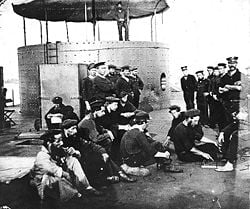
At the time of the earliest Egyptian pharaohs, a popular, checkers-like game called Alquerque was played on a five-by-five board. The ancient Greeks had a similar game as far back as 1600 B.C.E., with classical Greek philosophers Homer and Plato mentioning it in their works. So great was the attraction of the game that it was played throughout the Western World for thousands of years.
In France, the game was known as Fierges. The rules changed in about 1100 when the French utilized a 64-square chessboard to play the game. The newer French version was called Jeu Force (Strong Game), while the older version considered a gentile, social game for women and therefore known as Le Jeu Plaisant De Dames (Pleasant Game for Ladies).
Later, the rules for checkers became fixed and the game found a ready pool of players in Great Britain and America. In England, the game was called "draughts." The game became fundamentally the same as modern checkers when the rule requiring the capture of opposing pieces was added. In mid-sixteenth century Spain, books were written on the game. In 1756, William Payne, an English mathematician, wrote a learned treatise on draughts.
The game has never relinquished its popularity, with the first world championship occurring in 1847. However, it was eventually realized that with specific openings, the side to move first always had the advantage. Therefore, in 1934, opening move restrictions were created for expert players, beginning games in a seemingly random manner.
Rules
English draughts/checkers is played by two people on opposite sides of a playing board, alternating moves. One player has dark pieces, and the other has light pieces. Often, the board alternates between red and black squares. Pieces move diagonally and pieces of the opponent are captured by jumping over them.
The rules are:
- Board—The board is an eight-by-eight grid, with alternating dark and light squares, called a checkerboard (also the source of the name checkers in the U.S.). The playable surface consists of the 32 dark squares only.
- Pieces—The pieces are usually made of wood or plastic and are flat and cylindrical. They are invariably split into one darker and one lighter color. Traditionally, these colors are red and white. There are two kinds of pieces: "Men" and "kings." Kings are differentiated as consisting of two normal pieces of the same color, stacked one on top of the other. Often, indentations are added to the pieces to aid stacking.
- Starting Position—Each player starts with 12 pieces on the three rows closest to their own side, as shown in the diagram. The row closest to each player is called the "crownhead" or "kings row." The black (darker color) side moves first, moving forward one square diagonally.
- Kings—If a player's man moves into the kings row on the opposing player's side of the board, that piece is said to be "crowned" (or often "kinged" in the U.S.), becoming a "king" and gaining the ability to move both forwards and backwards.
- How to Move—There are two ways to move a piece: Simply sliding a piece diagonally forwards (also diagonally backwards in the case of kings) to an adjacent and unoccupied dark square, or "jumping" one of the opponent's pieces. In this case, one piece "jumps over" the other, there is a vacant square on the opposite side for it to land on. A "man" can only jump diagonally forwards, but a "king" can also move diagonally backwards. A piece that is jumped is captured and removed from the board. Multiple-jump moves are possible if, when the jumping piece lands, there is another piece that can be jumped. Jumping is mandatory and cannot be passed up to make a non-jumping move, nor can fewer than the maximum jumps possible be taken in a multiple-jump move. When there is more than one way for a player to jump, one may choose which sequence to make, not necessarily the sequence that will result in the most amount of captures. If a player's man jumps into the kings row, the current move terminates; having just been crowned, the piece cannot continue on by jumping back out (as in a multiple jump), until the next move.
- How the Game Ends—A player wins by capturing all of the opposing player's pieces, or by leaving the opposing player with no legal moves.
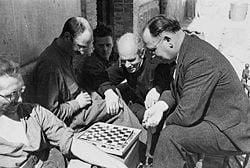
In tournament play, a variation called "three-move restriction" is preferred. The first three moves are drawn at random from a set of accepted openings. Two games are played with the chosen opening, each player having a turn at either side. This tends to reduce the number of draws and makes for more exciting matches. Three-move restriction has been played in the United States championship since 1934. A two-move restriction was used from 1900 until 1934 in the United States and in the British Isles until the 1950s. Before 1900, championships were played without restriction: this style is called go-as-you-please (GAYP).
One rule of long standing that has fallen out of favor is the "huffing" rule. In this variation, jumping is not mandatory, but a piece that could have jumped, but failed to do so, may be taken—or "huffed"—by the opposing player at the beginning of his or her next turn. After huffing the offending piece, the opponent then takes his or her turn as normal. Huffing has been abolished by both the American Checker Federation and the English Draughts Association.
Two common misinterpretations of the rules are:
- That the game ends in a draw when a player has no legal move
- That a piece which in the current move has become a king can then in the same move go on to capture other pieces
Computer players
The first computer English draughts program was written by C. S. Strachey, M.A., National Research Development Corporation, London, in the early 1950s. The second computer program was written in 1956, by Arthur Samuel, a researcher from IBM. It was one of the most complicated game playing programs written at the time, it is also well known for being one of the first adaptive programs, an early form of artificial intelligence. It learned by playing games against modified versions of itself, with the victorious versions surviving. Samuel's program was far from mastering the game, although one win against a known checkers master gave the general public the impression that it was very good.
In the 1990s, the strongest checkers program was Chinook, written in 1989, by a team from the University of Alberta led by Jonathan Schaeffer. Marion Tinsley, world checkers champion from 1955-1962 and 1975-1991, won a match against the machine in 1992. In 1994, Tinsley had to resign in the middle of an even match for health reasons; he died shortly thereafter. In 1995, Chinook defended its man vs. machine title against Don Lafferty in a 32-game match where each had one win and one loss, and a record-setting 30 draws. In 1996, Chinook won in the USA National Tournament by the widest margin ever, and was retired from play after that event. The man-machine title has not been contested since. The best computer programs of today are stronger than the best humans, and also stronger than Chinook was at the time when it won the man-machine title.
On July 2007, in an article published in Science Magazine, Chinook's developers announced that the program had been improved to the point where it could not lose a game. If no mistakes were made by its opponent, the game would always end in a draw.
ReferencesISBN links support NWE through referral fees
- English Draughts Association. English Open Draughts Championships. England: English Draughts Association, 1975. OCLC 37797745.
- English Draughts Association. Constitution, Rules and Tournament Regulations. Rotherham, England: W. Ball, 1961. OCLC 68064147.
- Pask, Richard. The English Draughts Association Handbook. England, Checkered Thinking, 1991. ISBN 978-1872796031.
- Smith, Pamela Rose. Checkers. Ithaca, NY: P.R. Smith, 2005. OCLC 71246092.
External links
All links retrieved February 13, 2024.
Credits
New World Encyclopedia writers and editors rewrote and completed the Wikipedia article in accordance with New World Encyclopedia standards. This article abides by terms of the Creative Commons CC-by-sa 3.0 License (CC-by-sa), which may be used and disseminated with proper attribution. Credit is due under the terms of this license that can reference both the New World Encyclopedia contributors and the selfless volunteer contributors of the Wikimedia Foundation. To cite this article click here for a list of acceptable citing formats.The history of earlier contributions by wikipedians is accessible to researchers here:
The history of this article since it was imported to New World Encyclopedia:
Note: Some restrictions may apply to use of individual images which are separately licensed.
